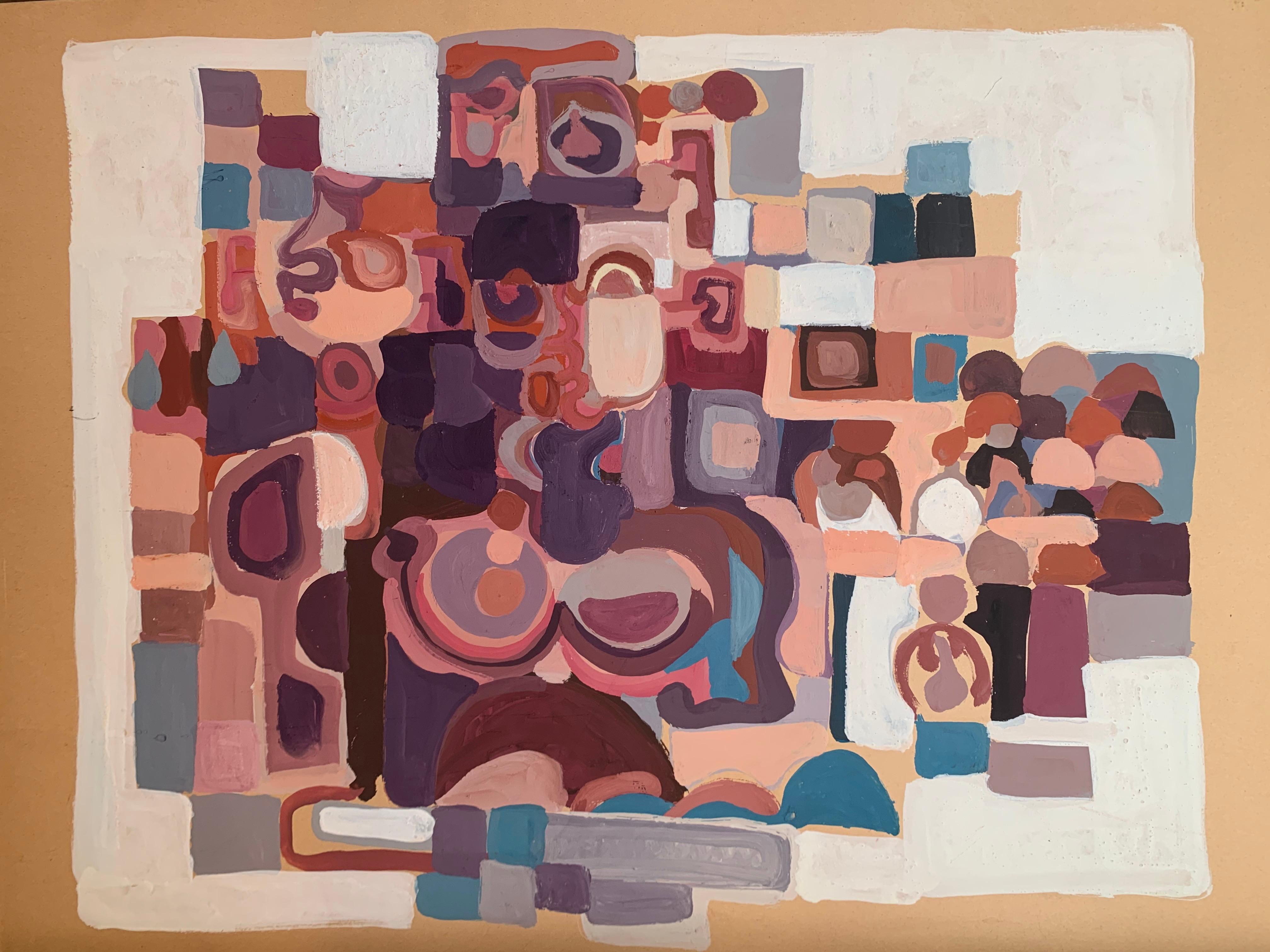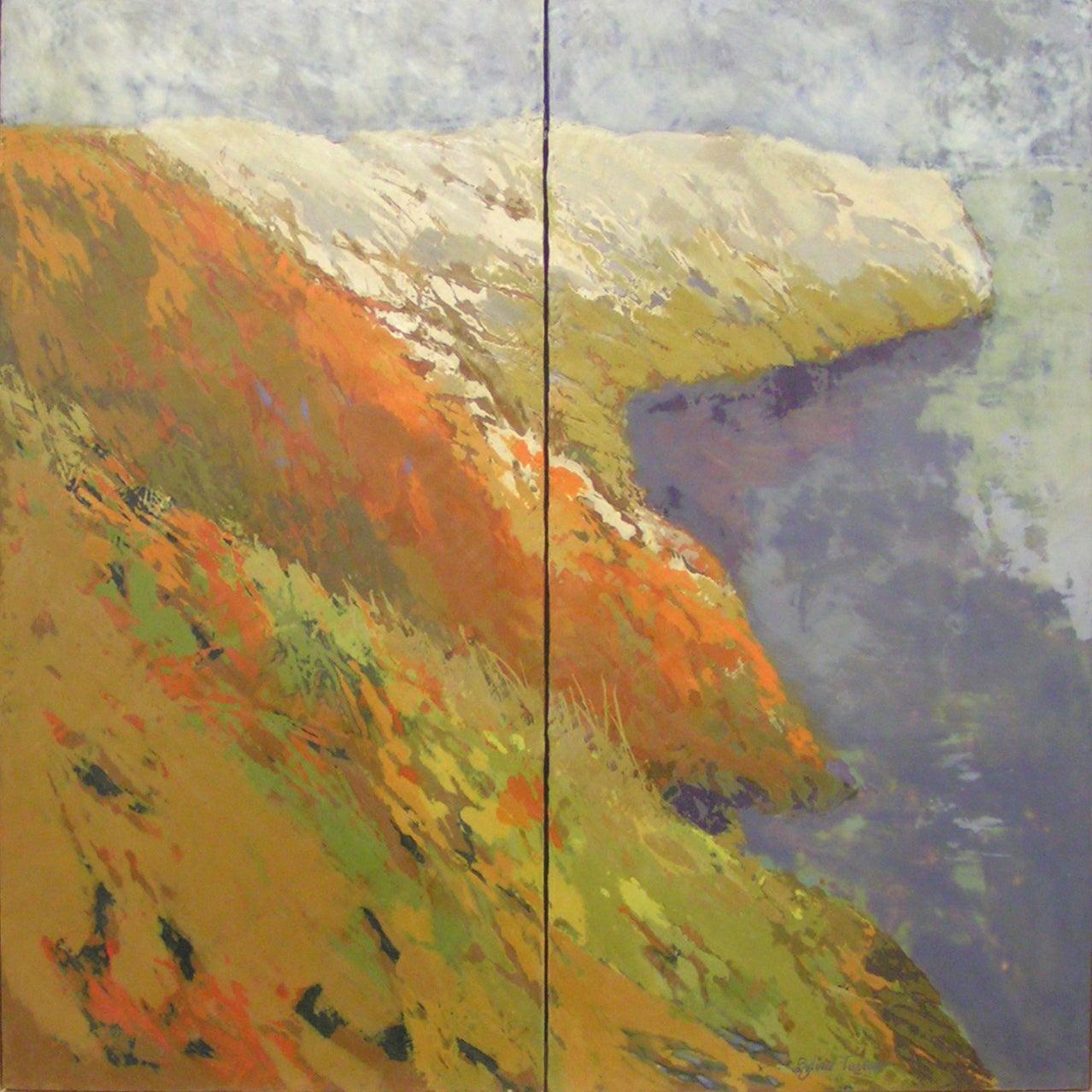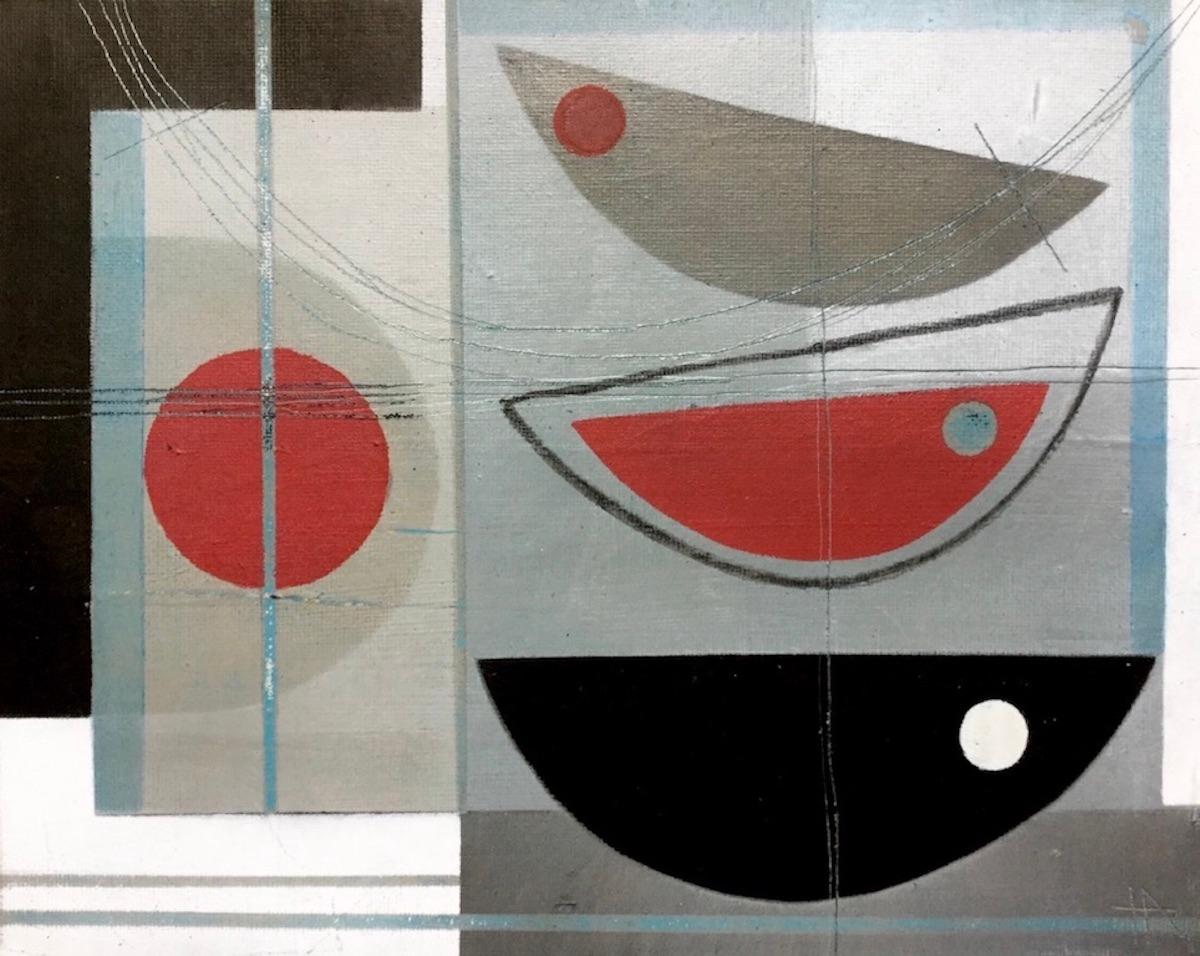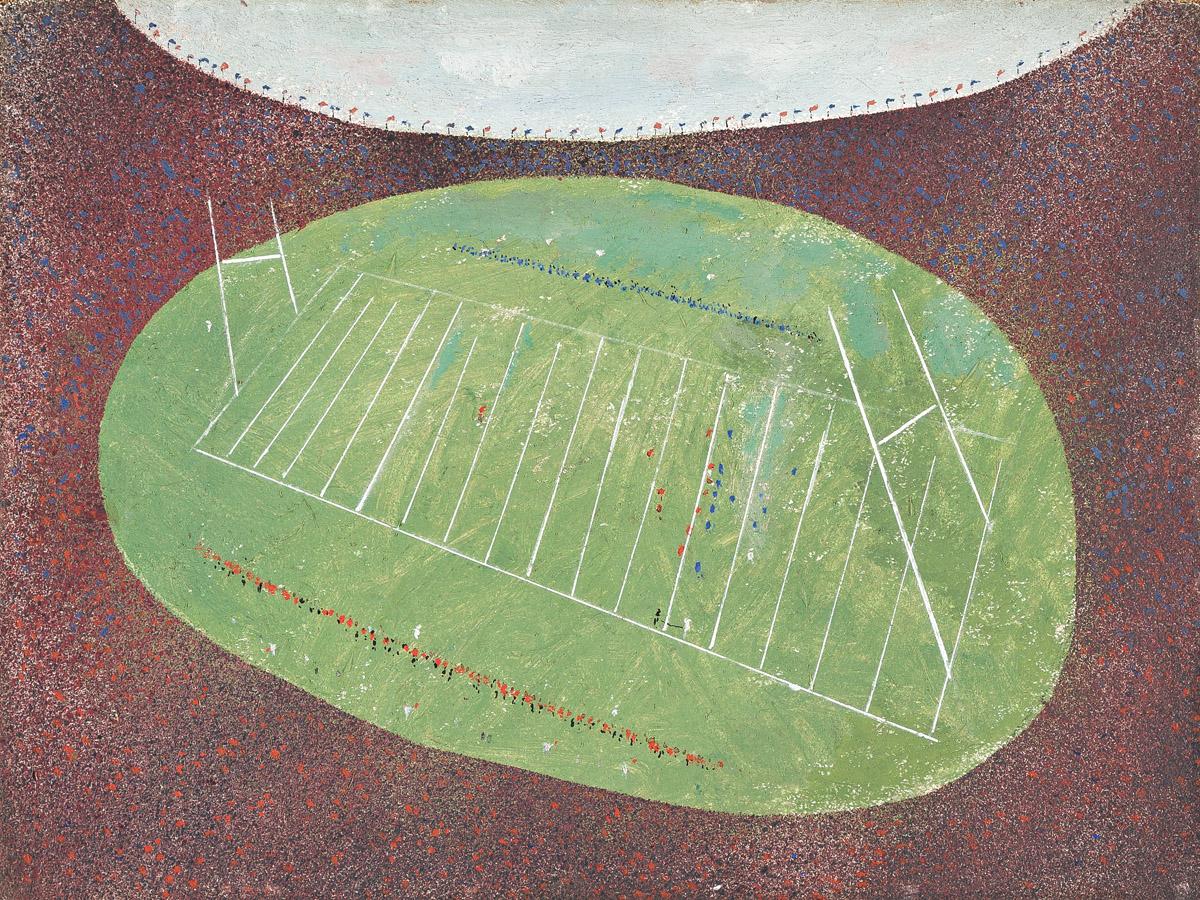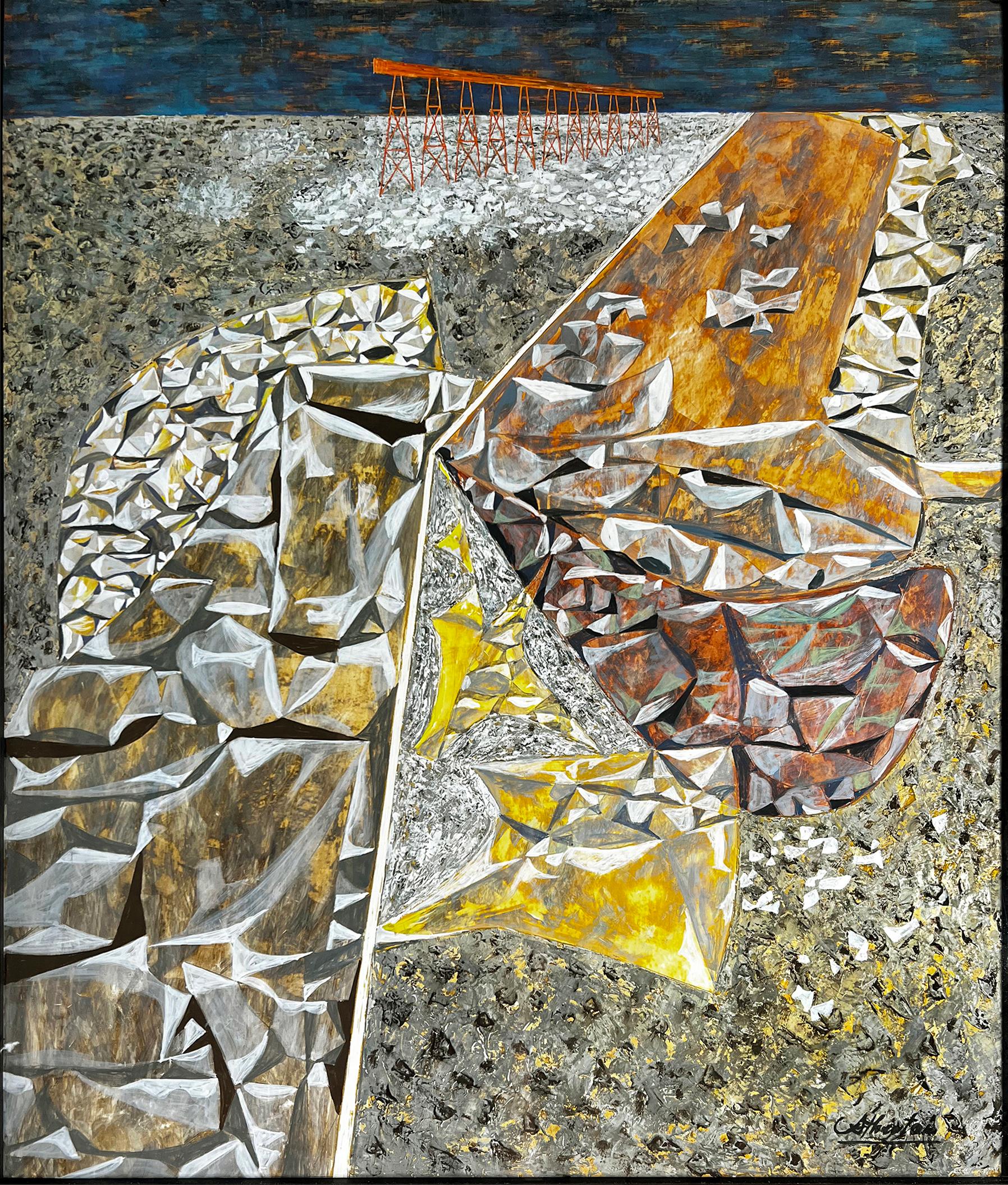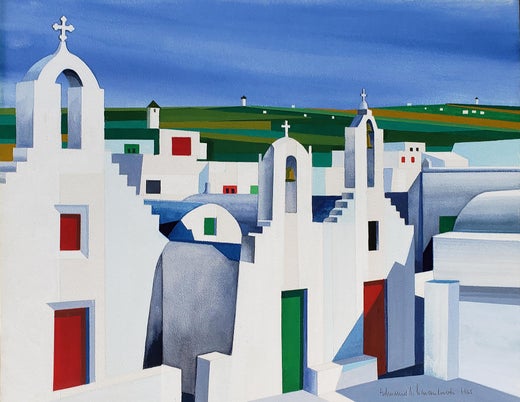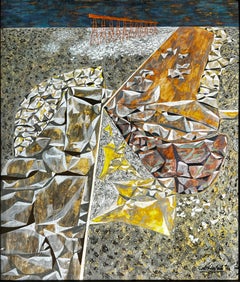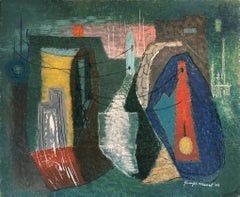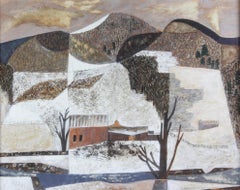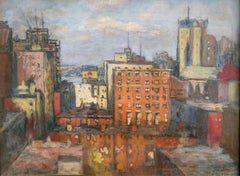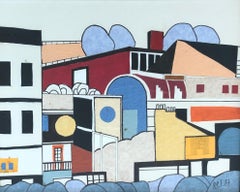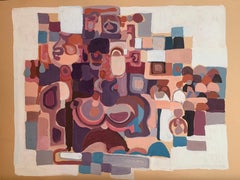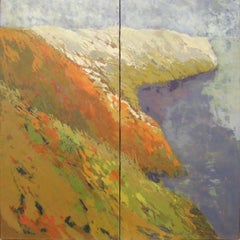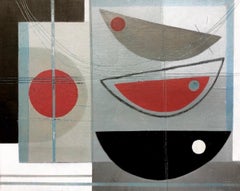Items Similar to Mykonos Church Landscape
Want more images or videos?
Request additional images or videos from the seller
1 of 7
Edmund LewandowskiMykonos Church Landscape1965
1965
About the Item
A vibrant example of the artist's precisionist style where a tight semi-abstract geometric composition is inspired by architecture and is reduced to simplified geometric shapes with a limited palette. Mykonos was a subject the artist explored in a variety of works some of which became multiples. From a private collection - Dorothy Sielaff, who, together with her husband (long deceased), was a lifelong friend of Lewandowski's. Dorothy worked with Lewandowski at the Layton Gallery in Milwaukee and they remained friends ever after. Dorothy Sielaff acquired the painting directly from Edmund Lewandowski.- Condition is excellent and work is framed in a simple period frame
- Creator:Edmund Lewandowski (1914 - 1998, American)
- Creation Year:1965
- Dimensions:Height: 16 in (40.64 cm)Width: 20 in (50.8 cm)
- Medium:
- Movement & Style:
- Period:
- Condition:
- Gallery Location:Miami, FL
- Reference Number:1stDibs: LU38538815572
Edmund Lewandowski
Regarded as a leading American precisionist and exemplary arts educator, Edmund D. Lewandowski once explained that his “overwhelming desire . . . through the years has been to record the beauty of man-made objects and energy of American industry,” a goal he successfully achieved in a career that spanned five decades and numerous locations, including the American Midwest, South, and New England. Born to Polish parents in Milwaukee, Wisconsin, Lewandowski attended the Layton School of Art, studying under regionalist artist Gerrit Sinclair. Inspired by Sinclair’s modern style and urban subjects, Lewandowski’s early paintings reflect a similar approach that would later evolve to industrial themes executed in a hard-edged precisionist manner. His most well-known subjects include chemical plants, shipyards, factories, farms, and oil rigs. Following graduation, Lewandowski worked as a public school teacher and commercial artist while pursuing his painting. His career took a significant step forward when, in 1936, his work caught the eye of the progressive art dealer Edith Halpert, who offered him representation at her celebrated Downtown Gallery in New York City. A key figure in modern art, Halpert encouraged Lewandowski to experiment with Precisionism and to remain in Milwaukee. In 1937, Lewandowski met Charles Sheeler, considered a leader in the American Precisionist movement, whose style would most significantly influence the younger artist’s career. Through his association with the Downtown Gallery and the work he executed for the Federal Art Project between 1936 and 1939, Lewandowski attracted important critical notice and was included in exhibitions at such notable institutions as the Metropolitan Museum of Art, Museum of Modern Art (Magic Realism exhibition), and Art Institute of Chicago during the 1940s alone. At the Downtown Gallery, he exhibited alongside other artists such as Charles Demuth, Georgia O'Keeffe, Ralston Crawford, George Ault, and Niles Spencer. Following military service as an Air Force mapmaker and camouflage artist from 1942–1946, Lewandowski joined the faculty of his alma mater, the Layton School of Art, in 1947. From that time on, he divided his time between creating art and teaching another generation of aspiring artists. His teaching career took him to institutions throughout the United States, including Florida State University. Following his tenure at Florida State, Lewandowski returned to Layton as its director, remaining until 1972. Throughout these years, the artist would create and exhibit works on paper and canvas, as well as execute commissioned large-scale mosaic murals. In 1973, Lewandowski joined the faculty at Winthrop University in Rock Hill, South Carolina, where he would serve as the art department chair until his retirement in 1984. Edmund Lewandowski’s art showcases an exacting technical skill honed in his early training and advanced by his relationship with Sheeler. His ultrarealistic works painted in watercolor, gouache, or oil range from early farmscapes to industrial scenes and marine subjects, a variety that reflects the artist’s constant quest for aesthetic evolution. Today, Lewandowski’s work can be seen at prestigious national museums.
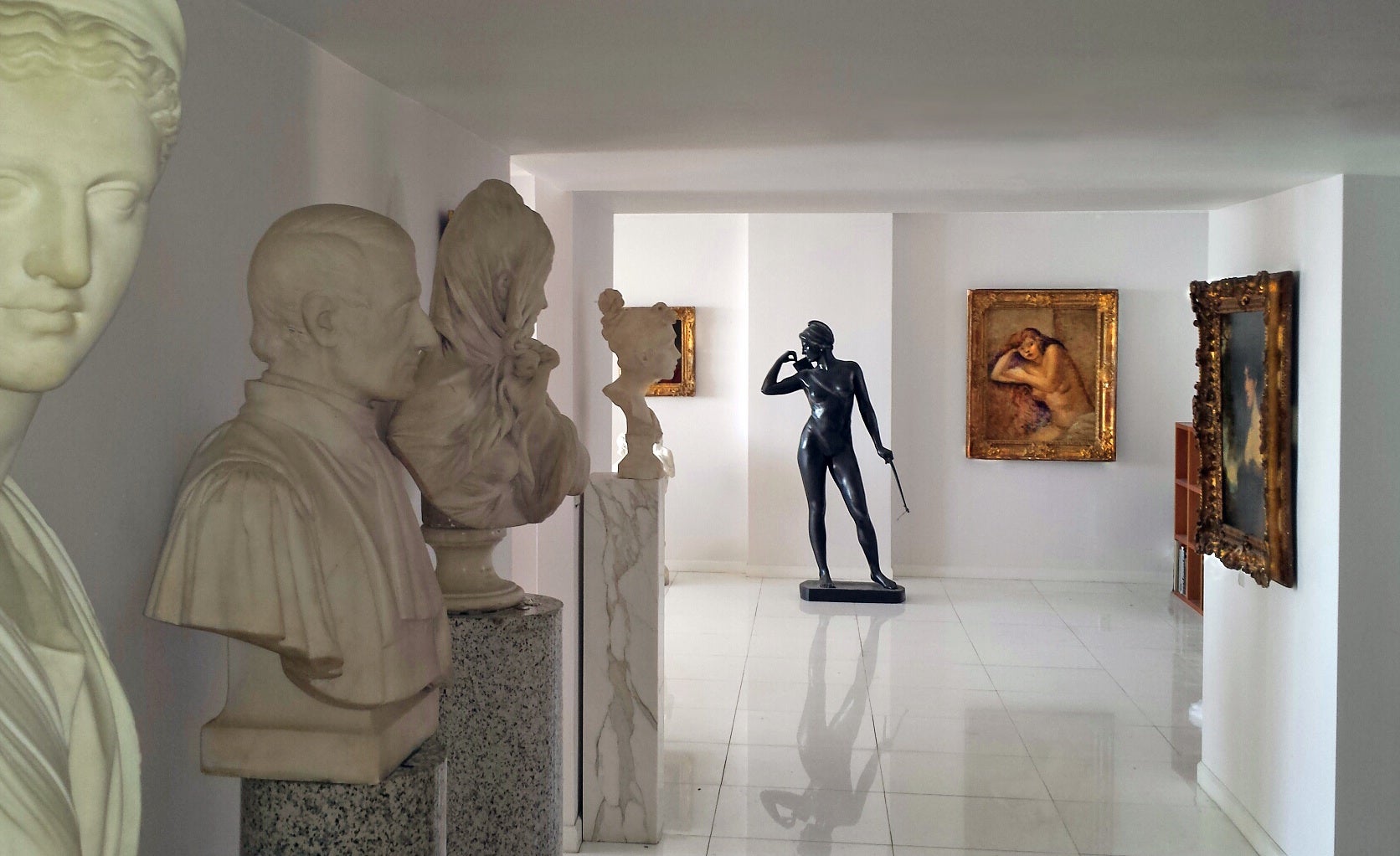
About the Seller
4.9
Vetted Professional Seller
Every seller passes strict standards for authenticity and reliability
Established in 2005
1stDibs seller since 2016
112 sales on 1stDibs
Typical response time: <1 hour
- ShippingRetrieving quote...Shipping from: Miami, FL
- Return Policy
Authenticity Guarantee
In the unlikely event there’s an issue with an item’s authenticity, contact us within 1 year for a full refund. DetailsMoney-Back Guarantee
If your item is not as described, is damaged in transit, or does not arrive, contact us within 7 days for a full refund. Details24-Hour Cancellation
You have a 24-hour grace period in which to reconsider your purchase, with no questions asked.Vetted Professional Sellers
Our world-class sellers must adhere to strict standards for service and quality, maintaining the integrity of our listings.Price-Match Guarantee
If you find that a seller listed the same item for a lower price elsewhere, we’ll match it.Trusted Global Delivery
Our best-in-class carrier network provides specialized shipping options worldwide, including custom delivery.More From This Seller
View AllThought Provoking Rock Quarry - Mid Century Abstract
Located in Miami, FL
This meticulously planned, designed, and executed work depicts an ultra-wide angle view of a rock quarry/mine. The viewer looks down at close-up-stylized rock formations and then out at a horizon line with rust-colored mine trestles. Atherton hints at perspective with a broken white line that is wider in the foreground and tapers to a hairline as it recedes to the background. The work was done in 1951 at the height of America's most important art movement: Abstract Expressionism. John Atherton absorbs its influences but retains elements of representation. Atherton was an in-demand commercial artist who worked for most blue-chip clients. It is possible that this was an editorial assignment for Fortune Magazine. At the same time, Atherton was also a fine artist and the work could be an expression of pure creative pursuits. The work looks better in person and one can look at it for hours and not get bored. Look carefully and you may discover a deeper meaning in this painting of precisely arranged rocks. Signed lower right.
Brooklyn Museum of Art, New York, sold to benefit the acquisitions program
____________________
From Wikipedia, the free encyclopedia
John Carlton Atherton (January 7, 1900 - September 16, 1952) was an American painter and magazine illustrator, writer and designer. His works form part of numerous collections, including the Museum of Modern Art,[1] Whitney Museum of American Art and the Smithsonian American Art Museum.[2][3][4]
Early Years
He was the son of James Chester Atherton (1868-1928) and Carrie B. Martin (1871-1909). He was born in Brainerd, Minnesota.[5] His father was Canadian born. His parents relocated from Minnesota to Washington State, with his maternal grandparents whilst he was still an infant. He attended high school in Spokane, Washington.
Career
During his early years he never displayed an aptitude for art; rather, his first love being nature and the activities he relished there, mainly fishing and hunting. He enlisted in 1917, serving briefly in the U.S. Navy for a year during World War I. At the end of the war, determined to get an education he worked various part-time jobs, as a sign painter and playing a banjo in a dance band to pay his enrolment fee at the College of the Pacific and The California School of Fine Arts (now the San Francisco Art Institute). Once there, he also worked in the surrounding studios developing his oil painting techniques.
A first prize award of $500 at the annual exhibition of the Bohemian Club in 1929, financed his one way trip to New York City, which helped to launch his career as an artist.[6]
Atherton had aspired to be a fine artist, however his first paid jobs were for commercial art firms designing advertisements for corporations such as General Motors, Shell Oil, Container Corporation of America, and Dole. However, by 1936, encouraged primarily by friends, such as Alexander Brook, an acclaimed New York realist painter, he returned to the fine arts.
Atherton continued to accept numerous commissions for magazine illustrations; such as Fortune magazine, and over the years he would paint more than forty covers for The Saturday Evening Post starting with his December 1942 design, “Patient Dog.” This picture is reminiscent of his friend Norman Rockwell ‘Americana style’ and captures a poignant moment of nostalgia, where a loyal dog looks toward a wall of hunting equipment and a framed picture of his owner in military uniform.
Selected One person Exhibitions
Atherton accomplished his first one-man show in Manhattan in 1936. His Painting, “The Black Horse” won the $3000 fourth prize from among a pool of 14,000 entries. This painting forms part of the Metropolitan Museum of Art collection in New York.[7]
Atherton achieved recognition in New York City and elsewhere during the 1930s. Having exhibited at the Julien Levy Gallery in New York,[8] his paintings began to be collected by museums; including the Museum of Modern Art[9] and the Metropolitan Museum of Art.
His reputation increased with his art deco stone lithograph poster for the 1939 New York World's Fair. In 1941, his design won first place in the Museum of Modern Arts “National Defense Poster Competition”.
Selected Public Collections
Fleming Museum of Art, Burlington, Vermont
Albright-Knox Art Gallery,[10] Buffalo, NY
Art Institute of Chicago,[11] Chicago
Wadsworth Atheneum,[12] Hartford, CT
Brooklyn Museum of Art, New York
Metropolitan Museum of Art, New York
The Museum of Modern Art,[13] New York
Whitney Museum of American Art,[14] New York
Pennsylvania Academy of the Fine Arts,[15] Philadelphia
De Young Museum,[16] San Francisco
Smithsonian American Art Museum,[17] Washington DC
Butler Institute of American Art[18] Youngstown, OH
The Famous Artists School
Founded in 1948 in Westport, Connecticut, U.S.A. The idea was conceived by members of the New York Society of Illustrators (SOI), but due to the Society's legal status, could not be operated by it. SOI member Albert Dorne led the initiative to set up a separate entity, and recruited the support of Norman Rockwell, who was also an SOI member. For the founding faculty, Dorne recruited Atherton, as well as accomplished artists such as Austin Briggs, Stevan Dohanos, Robert Fawcett, Peter Helck, Fred Ludekens, Al Parker, Norman Rockwell, Ben Stahl, Harold von Schmidt and Jon Whitcomb.[19]
He collaborated with Jon Whitcomb with the book “How I Make a Picture: Lesson 1-9, Parts 1”.[20][21]
Society of Illustrators
Atherton as an active member from his arrival in New York. The society have owned many of his works. Ex-collection includes:
Rocking Horse (ca. 1949) [22]
Atherton, as his peers had many of his works framed by Henry Heydenryk Jr.[23]
Personal
On November 2, 1926, he married Polly “Maxine” Breese (1903-1997).[24][25] They had one daughter, Mary Atherton, born in 1932.
Atherton's often chose industrial landscapes, however found himself spending considerable time in Westport, Connecticut, with an active artistic community, and it became home for him, and his family. He then moved to Arlington, Vermont.[26]
Norman Rockwell enlisted Atherton in what was to be the only collaborative painting in his career.[27]
He was part of a group of artists including a Norman Rockwell, Mead Schaeffer and George Hughes who established residences in Arlington.[28] Atherton and Mead Schaeffer were avid fly fishermen and they carefully chose the location for the group,[29] conveniently located near the legendary Battenkill River.
In his free time, Atherton continued to enjoy fly-fishing.[30] He brought his artistic talent into the field of fishing,[31] when he wrote and illustrated the fishing classic, “The Fly and The Fish”.[32]
He died in New Brunswick, Canada in 1952,[33] at the age of 52 in a drowning accident while fly-fishing.[34]
Legacy
The Western Connecticut State University holds an extensive archive on this artist.[35]
His wife, Maxine also published a memoir “The Fly Fisher and the River” [36] She married Watson Wyckoff in 1960.
Ancestry
He is a direct descendant of James Atherton,[37][38] one of the First Settlers of New England; who arrived in Dorchester, Massachusetts in the 1630s.
His direct ancestor, Benjamin Atherton was from Colonial Massachusetts...
Category
1950s Abstract Expressionist Abstract Paintings
Materials
Mixed Media, Gouache, Board
City Scape Abstract Expressionist Composition -Jackson Pollack Friend
By Joseph Meert
Located in Miami, FL
The fame, notoriety, and monetary value of an artist's work in today's market are not based on one's talent and vision. Factors such as marketing and media momentum play a defining r...
Category
1940s Abstract Expressionist Abstract Paintings
Materials
Gouache, Board
Landscape in Winter
Located in Miami, FL
At a time when Abstract Expressionism was raging, realist painterJohn Atherton nods his head to the movement with a semi-abstract work. Meticulously rendered and carefully thought o...
Category
1950s Abstract Geometric Landscape Paintings
Materials
Oil
New York Skyline the West Side with Hudson River - Vintage New York
By Frank S. Hermann
Located in Miami, FL
Rooftop view of the upper West Side Manhattan as it looked in the 1930s. There is a rough indication of a billboard and a glimpse of the Hudson River. The cluster of buildings depic...
Category
1930s American Impressionist Landscape Paintings
Materials
Oil, Gouache, Board
Home, African Village Scene Orange Sky, African American Artist
Located in Miami, FL
An African village scene is characterized by bold colors and a punchy flat orange sky combined with a post-impressionist paint application for the tree and the house. In the foreground, we see an African mother with two children standing outside her "Home." The work is created by African American artist Vincent D. Smith. It is signed lower right, Vincent, showing homage to Vincent Van Gogh, from whom the art word borrows some influence. Clearly, Smith has developed his own personal style, combining an African American persona with an African subject matter.
Original metal frame under glass.
The uploaded video is coming up light. Use the still image as a reference for color.
Vincent DaCosta Smith (December 12, 1929 – December 27, 2003) was an American artist, painter, printmaker and teacher. He was known for his depictions of black life.
Early life
Vincent DaCosta Smith was born on December 12, 1929, in the Bedford-Stuyvesant[1] neighborhood of Brooklyn, to Beresford Leopole Smith and Louise Etheline Todd. Both were immigrants from Barbados.[2] He was raised in Brownsville, Brooklyn and Smith drew what he saw around him.[citation needed] He attended an integrated school where he studied piano and the alto sax.
worked a range of jobs before he became a full-time artist. At 16, he worked for the Lackawanna Railroad repairing tracks. At 17, Smith enlisted in the army and traveled with his brigade for a year.[3] It wasn't until after his time in the army that Smith began to paint and printmaking.[4] At the age of 22, Smith was working in a post office where he grew to be friends with fellow artist Tom Boutis.[1]
Art education
Tom Boutis took Smith to a Paul Cézanne show at the Museum of Modern Art in 1951. After seeing the Cézanne show, Smith resigned from his position at the post office and began reading extensively about art.
He studied at the Art Students League of New York with Reginald Marsh.[citation needed]
Later, he began to sit in on classes at the Brooklyn Museum Art School, where the instructors would let him join in on the lessons and the criticisms.[3] After attending classes at the Brooklyn Museum Art School and the Art Students League of New York, he was accepted and received a scholarship to the Skowhegan School of Painting and Sculpture in Maine,[4] where he studied from 1953 to 1956.
Beginning in 1954,[5] he started taking official classes at the Brooklyn Museum Art School, and studied painting, etching, and woodblock printmaking.[4]
Career
Smith was a figurative painter who used abstractions and materiality to make something new.[6] Smith's work depicts the rhythms and intricacies of black life through his prints and paintings.[7] Many of his paintings and prints rely heavily on patterns.[6] According to Ronald Smothers, Vincent D. Smith's work "stood as an expressionistic bridge between the stark figures of Jacob Lawrence and the Cubist and Abstract strains represented by black artists like Romare Bearden and Norman Lewis."[7] Smith has described his own work as "a marriage between Africa and the West."[3] Over his life, he worked in both painting and printmaking.
In 1959, Smith won the John Hay Whitney Fellowship which allowed him to travel to the Caribbean for a year.[8] During this year he was deeply inspired by the customs and lifestyle of the native people.[8] Throughout his life, Smith attended various art schools but it was not until turning 50 he returned to college to earn an official degree.[7]
From 1967 until 1976 he taught at the Whitney Museum’s Art Resource Center.[2] Later in 1985, he taught printmaking at the Center for Art and Culture of Bedford Stuyvesant.
Death and legacy
Smith died in Manhattan on the December 27, 2003 from lymphoma and related complications.[7] Smith was aged 74.[7]
His work is included in many public museum collections including Art Institute of Chicago,[9] Newark Museum of Art,[1] Museum of Modern Art (MoMA),[1] Metropolitan Museum of Art,[1] Yale University Art Gallery,[10] Davidson Art Center,[11] Fitzwilliam Museum,[12] Brooklyn Museum,[13] Albright-Knox Art Gallery,[14] Rhode Island School of Design Museum,[15] among others.
Exhibitions
Over the course of his career, he had over 25 one-man shows and had his work shown in over 30 group shows.[7]
Vincent D. Smith had shown in a range of galleries and museums over his life-span. In 1970, he had his first individual exhibition at the Fisk University in Nashville, Tennessee. His first retrospective was in 1989 at the Schenectady Museum in Schenectady, New York.[2]
Solo shows:
1974 - The Portland Museum of Art, Portland, Maine[2]
1974 - Studio Museum in Harlem, New York, New York[2]
1989 - Schenectady Museum (Retrospective 1964-1989), Schenectady, New York
Awards and honors
This section needs additional citations for verification. Please help improve this article by adding citations to reliable sources in this section. Unsourced material may be challenged and removed. (May 2020) (Learn how and when to remove this template message)
1959 – John Hay Whitney Fellowship, John Hay Whitney Foundation, New York City, New York[8]
1967 – Artist in Residence, Smithsonian Conference Center
1968 – Grant, The American Academy and National Institute of Arts and Letters, New York
1971 – Creative Public Service Award for the Cultural Council Foundation, New York
1973 – National Endowment of the Arts and Humanities Travel Grant, New York
1973-1974 – Childe Hassam Purchase Award, American Academy of Arts and Letters, New York City, New York
1974 – Thomas P. Clarke Prize, National Academy of Design, New York
1981 – Windsor and Newton Award, National Society of Painters in Casein and Acrylic , New York.
1985-1986 – Artist-in-Residence, Kenkeleba House Gallery, New York.
Works
Below are some selected works:
Study for Mural at Boys and Girls High School, 1972, Metropolitan Museum of Art, New York, New York
A Moment Supreme, 1972, Metropolitan Museum of Art, New York, New York
The Triumph of B.L.S., 1973, Metropolitan Museum of Art, New York, New York
Jonkonnu Festival, 1996, Metropolitan Museum of Art, New York, New York
Murals
Mural for Crotona/Tremont Social Service Center, The Human Resource Administration, New York, New York 1980[1]
Mural for Oberia D. Dempsey Multi-Service Center of Central Harlem, New York, New York 1989[1]
Publications
Print portfolios
Impressions: Our World, Volume I (a portfolio of seven etchings - five with aquatint, two with embossing). Emma Amos, Benny Andrews, Vivian Browne, Eldzier Cortor...
Category
1970s Post-War Landscape Paintings
Materials
Gouache
Industrial Landscape
By George Luks
Located in Miami, FL
Quick and confident brush strokes describe the gritty forms of perhaps steam engines or railroad yards. Luks bravura style of putting paint to canvas anticipates action painting of ...
Category
1930s Abstract Expressionist Landscape Paintings
Materials
Oil
$14,800 Sale Price
20% Off
You May Also Like
Architecture
Located in Genève, GE
Collage, mixed technique
Work on paper
Black wooden frame with glass pane
75.3 x 93.2 x 3.7 cm
Category
1980s Abstract Geometric Abstract Paintings
Materials
Adhesive, Gouache, Tissue Paper
Abstract Urban landscape. 1970 circa
Located in Firenze, IT
Abstract Urban landscape. 1970 circa
Abstract Geometric Composition with Figures and Architecture
Artist: Unattributed
Date: Circa 1970
Medium: Oil on cardboard
Dimensions: H 65 c...
Category
1970s Abstract Geometric Abstract Paintings
Materials
Oil, Cardboard
Coastal Fugue #1
By Sylvia Torres
Located in Palm Desert, CA
This is the beautiful island Santa Rosa, one of the Channel Islands Sanctuary islands just off the California mainland. This vast stretch is adorned with a variety of fiery wildflowers stretching far and wide, like a musical composition of various themes and in different voices. Santa Rosa is home to an incredible array of birds and marine life.
It is a narrow but spreading landscape ribboned with trails, each one seemingly in the manner of a flight or chase, repeating the same melody in a slight variation. The cliffs drop hundreds of feet to the crashing swells of ocean below, home to historic shipwrecks peacefully intact.
Torres’ paintings appear on the sets of popular television shows: Big Little Big Lies, Criminal Minds, Chicago Med, Grey’s Anatomy...
Category
21st Century and Contemporary Abstract Geometric Abstract Paintings
Materials
Encaustic, Board
$6,000 Sale Price
39% Off
Noir et rouge
Located in Deddington, GB
Heidi Archer – Noir et rouge is an original oil and acrylic abstract painting with charcoal on canvas board.
Inspired by the boats, equipment and ropes in around our local harbour a...
Category
21st Century and Contemporary Abstract Geometric Abstract Paintings
Materials
Canvas, Charcoal, Oil, Acrylic, Board
"Harvard vs Yale" Charles Green Shaw, Football, Ivy League Sports, Abstract
By Charles Green Shaw
Located in New York, NY
Charles Green Shaw
Harvard vs. Yale, 1944
Signed and dated on the reverse
Oil on canvasboard
9 x 12 inches
Provenance:
Harvey and Francois Rambach, New Jersey
Private Collection, California
Washburn Gallery, New York
D. Wigmore Fine Art, New York
Private Collection, New York
Charles Green Shaw, born into a wealthy New York family, began painting when he was in his mid-thirties. A 1914 graduate of Yale, Shaw also completed a year of architectural studies at Columbia University. During the 1920s Shaw enjoyed a successful career as a freelance writer for The New Yorker, Smart Set and Vanity Fair, chronicling the life of the theater and café society. In addition to penning insightful articles, Shaw was a poet, novelist and journalist. In 1927 he began to take a serious interest in art and attended Thomas Hart Benton's class at the Art Students League briefly in New York. He also studied privately with George Luks, who became a good friend. Once he had dedicated himself to non-traditional painting, Shaw's writing ability made him a potent defender of abstract art.
After initial study with Benton and Luks, Shaw continued his artistic education in Paris by visiting numerous museums and galleries. From 1930 to 1932 Shaw's paintings evolved from a style imitative of Cubism to one directly inspired by it, though simplified and more purely geometric. Returning to the United States in 1933, Shaw began a series of abstracted cityscapes of skyscrapers he called Manhattan Motifs which evolved into his most famous works, the shaped canvases he called Plastic Polygons.
The 1930s were productive years for Shaw. He showed his paintings in numerous group exhibitions, both in New York and abroad, and was also given several one-man exhibitions. Shaw had his first one-man exhibition at the Valentine Dudensing Gallery in New York in 1934, which included 25 Manhattan Motif paintings and 8 abstract works. In the spring of 1935 Shaw was introduced to Albert Gallatin and George L.K. Morris. Gallatin was so impressed with Shaw's work, he broke a policy against solo exhibitions at his museum, the Gallery of Living Art, and offered Shaw an exhibition there. In the summer of 1935 Shaw traveled to Paris with Gallatin and Morris who provided introductions to many great painters. Shaw regularly spent time with John Ferren and Jean Hélion. The following year Gallatin organized an exhibition called Five Contemporary American Concretionists at the Reinhardt Gallery that included Shaw, Ferren, and Morris, Alexander Calder, and Charles Biederman...
Category
1940s Abstract Geometric Landscape Paintings
Materials
Oil, Board
$28,000 Sale Price
20% Off
Evening in The Tropics, Geometric Tiles in Yellow, Miami Sunset Patterns
By Natalia Roman
Located in Barcelona, ES
These series of paintings by Natalia Roman gather their inspiration from geometric, minimalist shapes and paintings from the beginning of Modernism, with a special emphasis on Art De...
Category
2010s Abstract Geometric Abstract Paintings
Materials
Watercolor, Acrylic, Rag Paper
Recently Viewed
View AllMore Ways To Browse
Botanical Book Prints
David Sassoon
Fishing Lithograph Art
French Wine Map
Frida Kahlo Photography
Hebrew Plate
Ice Cream Cone
Italian Church Architectural Print
Kaws Holiday
Large Scale Kinetic
Leonard Bernstein
Long Lunch
Map Of France Wine
Michael Kenna Paris
Nude With Mask
Oaxaca Sculpture
Old Pennies
Pablo Picasso Aquatint

